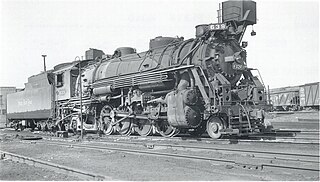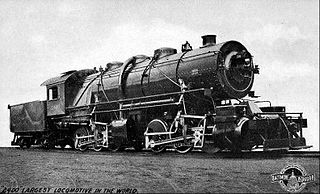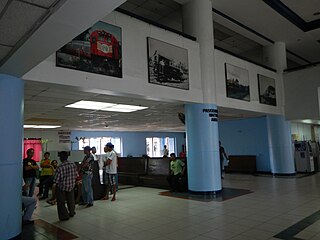
Under the Whyte notation for the classification of steam locomotives, 0-4-0 represents one of the simplest possible types, that with two axles and four coupled wheels, all of which are driven. The wheels on the earliest four-coupled locomotives were connected by a single gear wheel, but from 1825 the wheels were usually connected with coupling rods to form a single driven set.

0-6-0 is the Whyte notation designation for steam locomotives with a wheel arrangement of no leading wheels, six powered and coupled driving wheels on three axles, and no trailing wheels. Historically, this was the most common wheel arrangement used on both tender and tank locomotives in versions with both inside and outside cylinders.

Under the Whyte notation for the classification of locomotives, 4-6-4 represents the wheel arrangement of four leading wheels, six powered and coupled driving wheels and four trailing wheels. In France where the type was first used, it is known as the Baltic while it became known as the Hudson in most of North America.
Under the Whyte notation for the classification of steam locomotives, 2-10-2 represents the wheel arrangement of two leading wheels, ten powered and coupled driving wheels, and two trailing wheels. In the United States and elsewhere the 2-10-2 is known as the Santa Fe type, after the Atchison, Topeka and Santa Fe Railway that first used the type in 1903.

H.K. Porter, Inc. (Porter) manufactured light-duty railroad locomotives in the US, starting in 1866. The company became the largest producer of industrial locomotives, and built almost eight thousand of them. The last locomotive was built in 1950, but the company continues to produce industrial equipment to this day.

Under the Whyte notation for the classification of steam locomotives, 2-8-2 represents the wheel arrangement of two leading wheels on one axle, usually in a leading truck, eight powered and coupled driving wheels on four axles and two trailing wheels on one axle, usually in a trailing truck. This configuration of steam locomotive is most often referred to as a Mikado, frequently shortened to Mike.

Under the Whyte notation for the classification of steam locomotives, a 0-6-6-0 wheel arrangement refers to a locomotive with two engine units mounted under a rigid locomotive frame, with the front engine unit pivoting and each engine unit with six coupled driving wheels without any leading or trailing wheels. The wheel arrangement was mostly used to describe Mallet locomotive types and in some occasions, Double Fairlie locomotives.
A Meyer locomotive is a type of articulated locomotive. The design was never as popular as the Garratt or Mallet locomotives. It can be best regarded as 19th Century competition for the early compound Mallet and also the Fairlie articulated designs. Most single cab modern trains are of a similar design such as power cars, freight diesel locomotives, and some passenger locomotives.

Under the Whyte notation for the classification of steam locomotives, 2-6-0+0-6-2 represents the wheel arrangement of an articulated locomotive with two separate swivelling engine units, arranged back to back with the boiler and cab suspended between them. Each engine unit has two leading wheels in a leading truck, six powered and coupled driving wheels on three axles and no trailing wheels.

Under the Whyte notation for the classification of steam locomotives, 0-6-0+0-6-0 represents the wheel arrangement of an articulated locomotive with two separate swivelling engine units, each unit with no leading wheels, six powered and coupled driving wheels on three axles and no trailing wheels. The arrangement is effectively two 0-6-0 locomotives operating back-to-back and was used on Garratt, Double Fairlie, Meyer and Kitson-Meyer articulated locomotives. A similar arrangement exists for Mallet steam locomotives on which only the front engine unit swivels, but these are referred to as 0-6-6-0.

Three foot gauge railways have a track gauge of 3 ft or 1 yard. This gauge is a narrow gauge and is generally found throughout North, Central, and South America. In Ireland, many secondary and industrial lines were built to 3 ft gauge, and it is the dominant gauge on the Isle of Man, where it is known as the Manx Standard Gauge. Modern 3 ft gauge railways are most commonly found in isolated mountainous areas, on small islands, or in large-scale amusement parks and theme parks. This gauge is also popular in model railroading, and model prototypes of these railways have been made by several model train brands around the world, such as Accucraft Trains (US), Aristo-Craft Trains (US), Bachmann Industries, Delton Locomotive Works (US), LGB (Germany), and PIKO (Germany).

The Manila Railroad 300 class of 1914 were cog locomotives used for the Antipolo line and the Aringay–Baguio branch of the PNR North Main Line. These were also known in the railroad's mechanical department as the R class.

The Manila Railroad 45 class of 1919 were twenty-one 4-6-0 Ten-wheeler steam locomotives. Twenty locomotives were built by American light duty locomotive manufacturer H.K. Porter, Inc. between 1919 and 1921 for the Manila Railroad Company (MRR). The so-called Porters were the most successful steam locomotive class in Philippine service. They carried express trains for passengers as well as short-range maintenance trains for 70 years and served both the MRR and its successor, the Philippine National Railways. However, like all tender engines from the Manila Railroad era, the last locomotive was scrapped in the 1990s without a single unit preserved.

The Manila Railroad 200 class were 2-10-2 Santa Fe steam locomotives operated by the Manila Railroad Company (MRR), predecessor of the Philippine National Railways. They were built alongside the 4-8-2 Mountain-type 170 class by the American Locomotive Company at its Brooks facility between 1921 and 1922. During its service at the MRR, it carried heavy freight trains on the South Main Line between Manila and the Bicol Region.

The Manila Railway 100 class of 1906 was a class of five 4-4-2 Atlantic type steam locomotives built by the North British Locomotive Company for the Manila Railway Company, a predecessor of the Philippine National Railways. They were the flagship locomotives of the Manila Railway from the late 1900s to the 1910s and were the first class of tender locomotives to operate in the Philippines. They hauled the Baguio Special, an express service between Manila and Baguio via Damortis station in Rosario, La Union.

The Manila Railroad 170 class were ten 4-8-2 Mountain steam locomotives operated by the Manila Railroad Company (MRR), predecessor of the Philippine National Railways. They were built alongside the 2-10-2 Santa Fe-type Manila Railroad 200 class by the American Locomotive Company at its Brooks facility between 1921 and 1922. During its service at the MRR, it carried passenger trains on the South Main Line between Manila and the Bicol Region.

The PNR North Main Line is one of the two trunk lines of the Philippine National Railways in the island of Luzon, the other being the PNR South Main Line. The line during its maximum extent led to various cities and municipalities in Central Luzon and the Ilocos Region.

The Manila Railway 70 class of 1908 was a class of at least twenty-two 0-6-2 side and well-tank locomotives built by the North British Locomotive Company. These locomotives were first put into service on a mainline during the late 1900s and early 1910s by the Manila Railway Company. Their primary purpose was to support the growing network and replace the aging Dagupan class engines. They were used on all the lines of the Manila Railway and its succeeding incarnation, the Manila Railroad. Over time, some locomotives were either scrapped or given to sugarcane plantations after being withdrawn. The last unit, No. 79, remained in service with the Pampanga Sugar Development Company as late as 1989.

The Manila Railroad Company (MRR) was a Filipino state-owned enterprise responsible for the management and operation of rail transport in the island of Luzon. It was originally established by an Englishman named Edmund Sykes as the private Manila Railway Co., Ltd. on June 1, 1887. British engineer Horace L. Higgins was then assigned at the helm in Manila as its first general manager. On July 7, 1906, a separate private entity named the Manila Railroad Company of New Jersey was established. The two companies continued to own the Luzon railroad network until February 4, 1916 when the Insular Government acquired both companies and absorbed them into the new Manila Railroad.

















